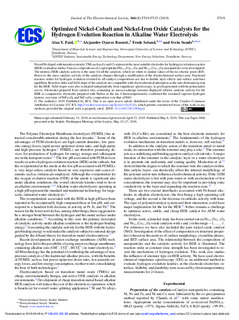| dc.contributor.author | Faid, Alaa | |
| dc.contributor.author | Barnett, Alejandro Oyarce | |
| dc.contributor.author | Seland, Frode | |
| dc.contributor.author | Sunde, Svein | |
| dc.date.accessioned | 2019-05-14T06:48:55Z | |
| dc.date.available | 2019-05-14T06:48:55Z | |
| dc.date.created | 2019-05-09T16:38:35Z | |
| dc.date.issued | 2019 | |
| dc.identifier.citation | Journal of the Electrochemical Society. 2019, 166 (8), F519-F533. | nb_NO |
| dc.identifier.issn | 0013-4651 | |
| dc.identifier.uri | http://hdl.handle.net/11250/2597474 | |
| dc.description.abstract | Ni and Ni-doped with transition metals (TM) such as Fe and Co represent the most suitable electrodes for hydrogen evolution reaction (HER) in alkaline media. Various compositions of co-precipitated Ni1 + xFe2 − xO4 and Ni1 + yCo2 − yO4 nanoparticles were investigated. The intrinsic HER catalytic activity is the same for all the catalysts, which we relate to similar values of the iso-electric point (IEP). However, the mass catalytic activity of the catalysts changes through a modification of the electrochemical surface area. Fractional reaction orders for hydrogen evolution revealed in all catalyst compositions are due to double layer effects and surface acid-base equilibria. Reaction order and Tafel slope of the catalysts are compatible with electrochemical adsorption as the rate-determining step for the HER. Tafel slopes were also evaluated independently from impedance spectroscopy, in good agreement with the polarization curves. Electrodes prepared from catalyst inks containing an anion-exchange ionomer displayed inferior catalytic activity for the HER as compared to electrodes prepared with Nafion in the ink. Chronoamperometry confirmed the sustained superior hydrogen kinetics over time of NiFe2O4 and NiCo2O4 composition over that of NiO. | nb_NO |
| dc.language.iso | eng | nb_NO |
| dc.publisher | ECS, The Electrochemical Society | nb_NO |
| dc.rights | Navngivelse 4.0 Internasjonal | * |
| dc.rights.uri | http://creativecommons.org/licenses/by/4.0/deed.no | * |
| dc.title | Optimized Nickel-Cobalt and Nickel-Iron Oxide Catalysts for the Hydrogen Evolution Reaction in Alkaline Water Electrolysis | nb_NO |
| dc.type | Journal article | nb_NO |
| dc.type | Peer reviewed | nb_NO |
| dc.description.version | publishedVersion | nb_NO |
| dc.source.pagenumber | F519-F533 | nb_NO |
| dc.source.volume | 166 | nb_NO |
| dc.source.journal | Journal of the Electrochemical Society | nb_NO |
| dc.source.issue | 8 | nb_NO |
| dc.identifier.doi | 10.1149/2.0821908jes | |
| dc.identifier.cristin | 1696758 | |
| dc.relation.project | Norges forskningsråd: 268019 | nb_NO |
| dc.description.localcode | Open Access CC-BY | nb_NO |
| cristin.unitcode | 194,66,35,0 | |
| cristin.unitcode | 194,64,25,0 | |
| cristin.unitname | Institutt for materialteknologi | |
| cristin.unitname | Institutt for energi- og prosessteknikk | |
| cristin.ispublished | true | |
| cristin.fulltext | original | |
| cristin.qualitycode | 2 | |

